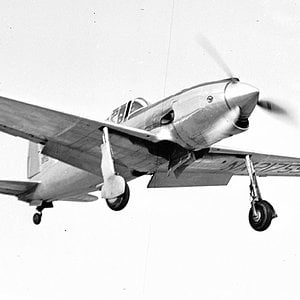Navigation
Install the app
How to install the app on iOS
Follow along with the video below to see how to install our site as a web app on your home screen.
Note: This feature may not be available in some browsers.
More options
You are using an out of date browser. It may not display this or other websites correctly.
You should upgrade or use an alternative browser.
You should upgrade or use an alternative browser.
XP-65
Proposed U.S. Army Air Force fighter.
XF7F-1
Prototype aircraft, two built.
F7F-1 Tigercat
Twin-engine fighter-bomber aircraft, powered by two Pratt & Whitney R-2800-22W radial piston engines. First production version, 34 built.
F7F-1N Tigercat
Single-seat night fighter aircraft, fitted with an APS-6 radar.
XF7F-2N
Night-fighter prototype, One built.
F7F-2N Tigercat
Two-seat night fighter, 65 built.
F7F-2D
Small numbers of F7F-2Ns converted into drone control aircraft. The aircraft were fitted with an F8F Bearcat-windshield behind the cockpit.
F7F-3 Tigercat
Single-seat fighter-bomber aircraft, powered by two Pratt & Whitney R-2800-34W radial piston engines, 189 built.
F7F-3N Tigercat
Two-seat night fighter aircraft, 60 built.
F7F-3E Tigercat
Small numbers of F7F-3s were converted into electronic warfare aircraft.
F7F-3P Tigercat
Small numbers of F7F-3s were converted into photo-reconnaissance aircraft.
F7F-4N Tigercat
Two-seat night-fighter aircraft, fitted with an arrestor hook and other naval equipment, 13 built.
General characteristics
Crew: 2 (pilot, radar operator)
Length: 45 ft 4 in (13.8 m)
Wingspan: 51 ft 6 in (15.7 m)
Height: 16 ft 7 in (5.1 m)
Wing area: 455 ft² (42.3 m²)
Empty weight: 16,270 lb (7,380 kg)
Max. takeoff weight: 25,720 lb (11,670 kg)
Powerplant: 2 × Pratt & Whitney R-2800-34W "Double Wasp" radial engines, 2,100 hp (1,566 kW) each
Performance
Maximum speed: 460 mph (400 knots, 740 km/h)
Range: 1,200 mi (1,000 nmi, 1,900 km)
Service ceiling: 40,400 ft (12,300 m)
Rate of climb: 4,530 ft/min (23 m/s)
Armament
Guns:
4 × 20 mm (0.79 in) M2 cannon
4 × 0.50 in (12.7 mm) M2 Browning machine gun
Bombs:
2 × 1,000 lb (454 kg) bombs under wings or
1 × torpedo under fuselage
Avionics
AN/APS-19 radar
Proposed U.S. Army Air Force fighter.
XF7F-1
Prototype aircraft, two built.
F7F-1 Tigercat
Twin-engine fighter-bomber aircraft, powered by two Pratt & Whitney R-2800-22W radial piston engines. First production version, 34 built.
F7F-1N Tigercat
Single-seat night fighter aircraft, fitted with an APS-6 radar.
XF7F-2N
Night-fighter prototype, One built.
F7F-2N Tigercat
Two-seat night fighter, 65 built.
F7F-2D
Small numbers of F7F-2Ns converted into drone control aircraft. The aircraft were fitted with an F8F Bearcat-windshield behind the cockpit.
F7F-3 Tigercat
Single-seat fighter-bomber aircraft, powered by two Pratt & Whitney R-2800-34W radial piston engines, 189 built.
F7F-3N Tigercat
Two-seat night fighter aircraft, 60 built.
F7F-3E Tigercat
Small numbers of F7F-3s were converted into electronic warfare aircraft.
F7F-3P Tigercat
Small numbers of F7F-3s were converted into photo-reconnaissance aircraft.
F7F-4N Tigercat
Two-seat night-fighter aircraft, fitted with an arrestor hook and other naval equipment, 13 built.
General characteristics
Crew: 2 (pilot, radar operator)
Length: 45 ft 4 in (13.8 m)
Wingspan: 51 ft 6 in (15.7 m)
Height: 16 ft 7 in (5.1 m)
Wing area: 455 ft² (42.3 m²)
Empty weight: 16,270 lb (7,380 kg)
Max. takeoff weight: 25,720 lb (11,670 kg)
Powerplant: 2 × Pratt & Whitney R-2800-34W "Double Wasp" radial engines, 2,100 hp (1,566 kW) each
Performance
Maximum speed: 460 mph (400 knots, 740 km/h)
Range: 1,200 mi (1,000 nmi, 1,900 km)
Service ceiling: 40,400 ft (12,300 m)
Rate of climb: 4,530 ft/min (23 m/s)
Armament
Guns:
4 × 20 mm (0.79 in) M2 cannon
4 × 0.50 in (12.7 mm) M2 Browning machine gun
Bombs:
2 × 1,000 lb (454 kg) bombs under wings or
1 × torpedo under fuselage
Avionics
AN/APS-19 radar








